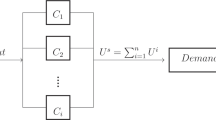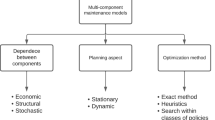Abstract
This paper presents a dynamic availability assessment of a large multi-component production system, taking into account the stochastic interdependence effect that has a negative impact on system availability. While this effect is detrimental to availability, it is necessary to consider it in maintenance modeling. The proposed model, which is based on the fractional-order model (FOM), takes into account the various states of system components, including the impacted, degraded, and failed states. We proposed an effective framework to compute a more realistic system availability, even for real systems in which the effect of interdependence occurs. The proposed model is validated using a numerical example, which provides an evaluation of the interdependence effect on various system variables. Additionally, a set of managerial insights is formulated, providing practical implications for maintenance planning and decision-making in large multi-component production systems.









Similar content being viewed by others
Availability of data and materials
The data that support the findings of this study are available from the corresponding author upon reasonable request.
References
Bahou Z, Krimi I, Elhachemi N, El Cadi AA (2022) Availability modelling and analysis of a two-component parallel system under stochastic dependence. Int J Math Oper Res (In press)
Amin MT, Khan F, Imtiaz S (2018) Dynamic availability assessment of safety critical systems using a dynamic Bayesian network. Reliabil Eng Syst Saf 178:108–117. https://doi.org/10.1016/j.ress.2018.05.017
Vital RBN, e Melo PF, Medeiros JACC, Alvarenga MAB, (2022) Availability assessment of a nuclear reactor limitation system by a Timed Petri Net. Progress Nuclear Energy 152:104380. https://doi.org/10.1016/j.pnucene.2022.104380
Leite M, Costa MA, Alves T, Infante V, Andrade AR (2022) Reliability and availability assessment of railway locomotive bogies under correlated failures. Eng Fail Anal 135:106104. https://doi.org/10.1016/j.engfailanal.2022.106104
Konstantakopoulos GD, Gayialis SP, Kechagias EP (2020) Vehicle routing problem and related algorithms for logistics distribution: a literature review and classification. Oper Res. https://doi.org/10.1007/s12351-020-00600-7
Martinod R, Estepa D, Paris C, Trujillo A, Pineda F, Castañeda L, Restrepo J (2015) Journey safety assessment to urban aerial ropeways transport systems based on continuous inspection during operation. J Transp Saf Secur 7(4):279–290. https://doi.org/10.1080/19439962.2014.942018
Wanqiang Xi et al (2018) Type synthesis of coordinated multi-robot system based on parallel thought. Trans Can Soc Mech Eng 42(2):164–176. https://doi.org/10.1139/tcsme-2017-0053
Kebede AA, Kalogiannis T, Van Mierlo J, Berecibar M (2022) A comprehensive review of stationary energy storage devices for large scale renewable energy sources grid integration. Renew Sustain Energy Rev 159:112213. https://doi.org/10.1016/j.rser.2022.112213
Aguilar H, García-Villoria A, Pastor R (2020) A survey of the parallel assembly lines balancing problem. Comput Oper Res 124:105061. https://doi.org/10.1016/j.cor.2020.105061
Khoshnaw SH, Salih RH, Sulaimany S (2020) Mathematical modelling for coronavirus disease (COVID-19) in predicting future behaviours and sensitivity analysis. Math Modell Nat Phenom 15:33. https://doi.org/10.1051/mmnp/2020020
Ould Beinane SA, Lemnaouar MR, Zine R, Louartassi Y (2022) Stability analysis of COVID-19 epidemic model of type with fractional order. Math Probl Eng. https://doi.org/10.1155/2022/5163609
Lemnaouar MR, Khalfaoui M, Benazza H, Louartassi Y (2019) A fractional order for prey-predator model with reserve area in the presence of toxicity. In 2019 5th International Conference on Optimization and Applications (ICOA) pp 1–4. IEEE. https://doi.org/10.1109/ICOA.2019.8727656
Lemnaouar MR, Khalfaoui M, Louartassi Y, Tolaimate I (2020) Fractional order prey-predator model with infected predators in the presence of competition and toxicity. Math Modell Nat Phenom 15:38. https://doi.org/10.1051/mmnp/2020002
Hattaf K, Dutta H (2020) Modeling the dynamics of viral infections in presence of latently infected cells. Chaos Solitons Fract 136:109916. https://doi.org/10.1016/j.chaos.2020.109916
Wang F, Chen D, Xu B, Zhang H (2016) Nonlinear dynamics of a novel fractional-order Francis hydro-turbine governing system with time delay. Chaos Solitons Fract 91:329–338. https://doi.org/10.1016/j.chaos.2016.06.018
Frenkel I, Lisnianski A, Khvatskin L (2012) Availability assessment for aging refrigeration system by using Lz-transform. J Reliabil Stat Stud. 5(2):33–43
Daichman S, Frenkel I, Khvatskin L, Lisnianski A (2013) On aging components impact on multi-state water cooling system: L z-transform application for availability assessment. In: The International Conference on Digital Technologies 2013 pp 156–161. IEEE. https://doi.org/10.1109/DT.2013.6566304
Meenakshi K, Singh SB (2016) Availability assessment of multi-state system by hybrid universal generating function and probability intervals. Int J Perform Eng 12(4):321–39
Gupta P, Goyal A (2010) Availability assessment of a multi-state repairable bubble gum production system. In: 2010 IEEE International Conference on Industrial Engineering and Engineering Management pp 631–635. IEEE. https://doi.org/10.1109/IEEM.2010.5674521
Thangamani G, Narendran TT, Subramanian R (1995) Assessment of availability of a fluid catalytic cracking unit through simulation. Reliabil Eng Syst Saf 47(3):207–220. https://doi.org/10.1016/0951-8320(94)00056-T
Hauptmanns U, Marx M, Grünbeck S (2008) Availability analysis for a fixed wet sprinkler system. Fire Saf J 43(7):468–476. https://doi.org/10.1016/j.firesaf.2008.03.002
Ebrahimipour V, Suzuki K (2005) An integrated model-based approach for evaluating and improving safety instruments in continuous process from the viewpoints of maintainability, reliability and availability-case study: offshore industry. J Chem Eng Jpn 38(6):436–445. https://doi.org/10.1252/jcej.38.436
Talebberrouane M, Khan F, Lounis Z (2016) Availability analysis of safety critical systems using advanced fault tree and stochastic Petri net formalisms. J Loss Prev Process Ind 44:193–203. https://doi.org/10.1016/j.jlp.2016.09.007
Rajpal PS, Shishodia KS, Sekhon GS (2006) An artificial neural network for modeling reliability, availability and maintainability of a repairable system. Reliabil Eng Syst Saf 91(7):809–819. https://doi.org/10.1016/j.ress.2005.08.004
Hassan J, Thodi P, Khan F (2016) Availability analysis of a LNG processing plant using the Markov process. J Qual Maint Eng 22(3):302–320. https://doi.org/10.1108/JQME-05-2012-0018
Weber P (2002) Dynamic bayesian networks model to estimate process availability. In: In 8th International Conference Quality, Reliability, Maintenance, CCF’02. Sinaia, Romania pp 184–189. MEDIAREX 21
Neil M, Marquez D (2012) Availability modelling of repairable systems using Bayesian networks. Eng Appl Artif Intell 25(4):698–704. https://doi.org/10.1016/j.engappai.2010.06.003
Buldyrev SV, Parshani R, Paul G, Stanley HE, Havlin S (2010) Catastrophic cascade of failures in interdependent networks. Nature 464(7291):1025–1028. https://doi.org/10.1038/nature08932
Laprie JC, Kanoun K, Kaâniche M (2007) Modelling interdependencies between the electricity and information infrastructures. In: Computer Safety, Reliability, and Security: 26th International Conference, SAFECOMP 2007, Nuremberg, Germany, September 18–21, 2007. Proceedings 26 pp 54–67. Springer Berlin Heidelberg. https://doi.org/10.1007/978-3-540-75101-4_5
Rosato V, Issacharoff L, Tiriticco F, Meloni S, Porcellinis S, Setola R (2008) Modelling interdependent infrastructures using interacting dynamical models. Int J Crit Infrastruct 4(1–2):63–79. https://doi.org/10.1504/IJCIS.2008.016092
Kurant M, Thiran P (2006) Layered complex networks. Phys Rev Lett 96(13):138701. https://doi.org/10.1103/PhysRevLett.96.138701
Xu K, Tang LC, Xie M, Ho SL, Zhu ML (2002) Fuzzy assessment of FMEA for engine systems. Reliabil Eng Syst Saf 75(1):17–29. https://doi.org/10.1016/S0951-8320(01)00101-6
Shen GX, Sun SG, Zhang YZ, Wang ZQ, Chen BK, Ma C (2014) System failure analysis based on DEMATEL-ISM and FMECA. J Central South Univ 21:4518–4525. https://doi.org/10.1007/s11771-014-2456-8
Liu HC, You JX, Shan MM, Su Q (2019) Systematic failure mode and effect analysis using a hybrid multiple criteria decision-making approach. Total Qual Manage Bus Excell 30(5–6):537–564. https://doi.org/10.1080/14783363.2017.1317585
Shahin A, Labib A, Emami S, Karbasian M (2018) Improving Decision-Making Grid based on interdependence among failures with a case study in the steel industry. TQM J 31(2):167–182. https://doi.org/10.1108/TQM-03-2018-0043
George-Williams H, Patelli E (2017) Efficient availability assessment of reconfigurable complex multi-state systems with interdependencies. In: Risk, Reliability and Safety: Innovating Theory and Practice-Proceedings of the 26th European Safety and Reliability Conference, ESREL 2016 p 409
Nourelfath M, Nahas N, Ben-Daya M (2016) Integrated preventive maintenance and production decisions for imperfect processes. Reliab Eng Syst Saf 148:21–31. https://doi.org/10.1016/j.ress.2015.11.015
Podlubny I (1999) An introduction to fractional derivatives, fractional differential equations, to methods of their solution and some of their applications. Math Sci Eng 198:340
Matignon D (1996) Stability results for fractional differential equations with applications to control processing. Comput Eng Syst Appl 2(1):963–968
Diethelm K, Freed AD (1998) The FracPECE subroutine for the numerical solution of differential equations of fractional order. Forschung und wissenschaftliches Rechnen 1999:57–71
Diethelm K, Ford NJ, Freed AD (2004) Detailed error analysis for a fractional Adams method. Numer Algor 36:31–52. https://doi.org/10.1023/B:NUMA.0000027736.85078.be
Diethelm K (2003) Efficient solution of multi-term fractional differential equations using P (EC) m E methods. Computing 71:305–319. https://doi.org/10.1007/s00607-003-0033-3
Jaber AA, Bicker R (2014) The state of the art in research into the condition monitoring of industrial machinery. Int J Curr Eng Technol 4:1986–2001
Li Y, Chen Y, Podlubny I (2010) Stability of fractional-order nonlinear dynamic systems: lyapunov direct method and generalized Mittag-Leffler stability. Comput Math Appl 59(5):1810–1821. https://doi.org/10.1016/j.camwa.2009.08.019. (4(3), 1986-2001)
Funding
No funding received.
Author information
Authors and Affiliations
Contributions
All the authors have contributed equally to this paper.
Corresponding author
Ethics declarations
Conflict of interest
The authors declare no potential conflicts of interest.
Ethical approval
Not applicable.
Appendix A
Appendix A
Theorem 4
The sufficient condition for the existence and uniqueness of the solution of system (6) in the region \(\Omega \times [t_0,T]\) with initial conditions \(N(0)=(S(0), E(0), I(0), Q(0),H(0),R(0),S_t(0))\) and \(t \in [t_0,T]\) is:
Proof
Let \(X=(S,E,I,Q,H,R,S_t)^{T}\) and \(X^{'}=(S',E',I',Q',H',R',S_t')^{T}\) the system (6) can be written in this form:
where
To prove the global existence and uniqueness of system (6), consider the region \(\Omega \times [t_0,T]\),
where \(\Omega =\left\{ (S,E,I,Q,H,R,S_t)\in \mathbb {R}^{7}_+: \max \left\{ S,E,I,Q,H,R,S_t\right\} \le M, M>0\right\}\). For any \(X, X'\in \Omega\):
where
which proves this Lemma. \(\square\)
Thus, F(X) satisfies the Lipschitz’s condition [44] with respect to X.
Rights and permissions
Springer Nature or its licensor (e.g. a society or other partner) holds exclusive rights to this article under a publishing agreement with the author(s) or other rightsholder(s); author self-archiving of the accepted manuscript version of this article is solely governed by the terms of such publishing agreement and applicable law.
About this article
Cite this article
Bahou, Z., Lemnaouar, M.R. & Krimi, I. A dynamic availability analysis of an N-component production system with interdependency effects: a fractional-order approach. Prod. Eng. Res. Devel. 18, 99–115 (2024). https://doi.org/10.1007/s11740-023-01216-4
Received:
Accepted:
Published:
Issue Date:
DOI: https://doi.org/10.1007/s11740-023-01216-4




